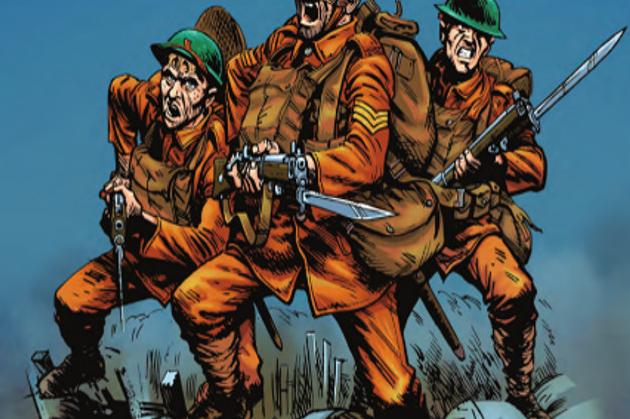CHARLEY'S WAR, VOLUME 2 REVIEW
Writers: Pat Mills
Artist: Joe Colquhoun
Letterers: John Aldrich, Jim Campbell, Mike Peters, Peter Knight
Publisher: Rebellion
It’s safe to say that you probably wont start your journey through Charley’s War here, with the second volume. Volume 1 was released just a few weeks ago, collecting the first three hundred pages of the story which ran for years in the 1980’s Battle Picture Weekly. Volume 1 was reviewed here at Comics the Gathering, and every superlative heaped upon that publication must be repeated here.
Volume 2 continues and develops the story of Charley Bourne, a young man who volunteers to serve in the British army during the Great War, and whose innocence and patriotism are eroded by the horrible reality of trench warfare.
This is a war story that in no way glorifies war or makes heroes of those who fight. A deeply political comic that takes the side of no politician or party, passionate instead about the fate of ordinary people fed into the grinder of war and propaganda. Charley’s War isn’t about a war between nations, but between humanity and inhumanity.
After developing Charley Bourne as a character for three hundred pages, Volume 2 takes the unusual step of telling a new story from different point of view. As Charley spends some much deserved time away from the trenches, he encounters the mysterious Blue, a French Legionnaire who has deserted and fled to Britain. This change of director not only allows writer Pat Mills to opportunity to tell the story of the Battle of Verdun, but shifts focus from a British Tommy to the range of different nationalities who took part in the Great War, as well as the stories of those desperate not to fight
If there’s a theme that runs through this second volume, it’s the story of the men who left the war behind. Volume 2 is full of deserters and conscientious objectors, of good men driven to run, and men broken by the constant horror of trench warfare. Writer Pat Mill’s skilled plotting slowly shifts the perception of these men. The original publication of Charley’s War printed these stories at the rate of three pages a week. The gradual shift from regarding deserters as cowards, to building an understanding of what drives brave men to flee, is subtle even when these tales are collected together.
That artist Joe Colquhoun was able to main this high a standard of work for so long is truly astounding. Highly detailed line art, packed with character, finds the perfect balance between stark realism and the decaying gothic horror of trench warfare. There is not a single bad panel. Characters are so memorable that even if they disappear for a hundred pages at a time, they are immediately recognisable upon their return.
Charley’s War is not only an incredible technical accomplishment, its an incredibly moving work of fiction. The (mostly) black and white art features no gore, but never shies from conveying shocking moments. When a grenade obliterates a character, there’s no blood or graphic body parts. Rather, the focus is on the survivors, grown men weeping for their lost friends, or staring dead eyed at the realisation that the lives they knew are gone.
Charley’s War is probably the greatest British comic every published, which is a hefty achievement given the number of talented creators originating on this side of the Atlantic. It’s easily the best anti-war comic, comparable with some great works of film and literature in the power of its message. It is intelligent in its politics, utilising stereotypes of race and class as quickly as it demolishes them. In terms of conveying tension and action, it’s up there with some of the best superhero comics.





